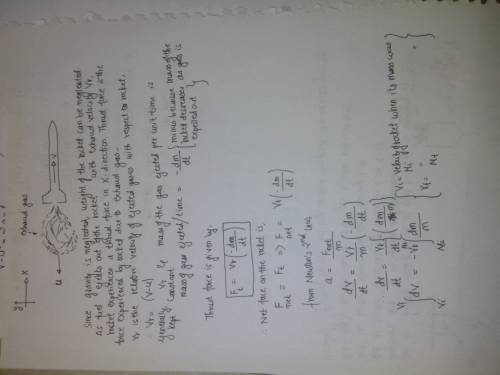
Physics, 21.07.2019 05:10 twirlergirl406
A4000 kg rocket is launched, shooting 50 kg of burned fuel from its exhaust at a velocity of -625 m/s. what is the velocity of the rocket after the fuel has burned? (ignore the effects of gravity as this rocket is in the deepest darkest regions of interstellar space)

Answers: 1
Another question on Physics

Physics, 21.06.2019 17:00
We all use gps today, even if we don't drive yet. i bet you have been in the car with a parent and they have asked you to get out your phone to find a specific location. in your car, on the phone, you are using a very sophisticated technology. gps satellites circle the earth twice a day in a very precise orbit and transmit signal information to earth. gps receivers take this information and use trilateration to calculate the user's exact location. essentially, the gps receiver compares the time a signal was transmitted by a satellite with the time it was received. the time difference tells the gps receiver how far away the satellite is. now, with distance measurements from a few more satellites, the receiver can determine the user's position and display it on the unit's electronic map. what type of signal is utilized by the gps satellite?
Answers: 2

Physics, 22.06.2019 18:30
Anonzero net force acts on a particle and does work. which one of the following statements is true? the kinetic energy of the particle changes, but the speed of the particle does not change. the kinetic energy of the particle does not change, but the speed of the particle does change. the kinetic energy of the particle changes, but the velocity of the particle does not change. the kinetic energy and the speed of the particle change, but the velocity of the particle does not change. the kinetic energy, speed, and velocity of the particle change.
Answers: 1

Physics, 22.06.2019 20:50
In a game of pool, ball a is moving with a velocity v0 of magnitude v0 = 15 ft/s when it strikes balls b and c, which are at rest and aligned as shown. knowing that after the collision the three balls move in the directions indicated and assuming frictionless surfaces and perfectly elastic impact (that is, conservation of energy), determine the magnitudes of the velocities va, vb, and vc.
Answers: 3

Physics, 22.06.2019 21:40
Wo small variable-thrust jets are actuated to keep the spacecraft angular velocity about the z-axis constant at ? 0 = 1.16 rad/s as the two telescoping booms are extended from r1 = 1.18 m to r2 = 4.69 m at a constant rate over a period of 124 seconds. the small 19-kg experiment modules at the ends of the booms may be treated as particles, and the mass of the rigid booms is negligible. determine the necessary thrust t for each jet as a function of time where t = 0 is the time when the telescoping action is begun. after you have the general expression for t, answer the questions. show work.
Answers: 1
You know the right answer?
A4000 kg rocket is launched, shooting 50 kg of burned fuel from its exhaust at a velocity of -625 m/...
Questions

Mathematics, 19.07.2019 13:30

Chemistry, 19.07.2019 13:30

Mathematics, 19.07.2019 13:30

Mathematics, 19.07.2019 13:30

Social Studies, 19.07.2019 13:30


Biology, 19.07.2019 13:30

Advanced Placement (AP), 19.07.2019 13:30

History, 19.07.2019 13:30

History, 19.07.2019 13:30


Mathematics, 19.07.2019 13:30

Social Studies, 19.07.2019 13:30


Social Studies, 19.07.2019 13:30

Geography, 19.07.2019 13:30



Social Studies, 19.07.2019 13:30




